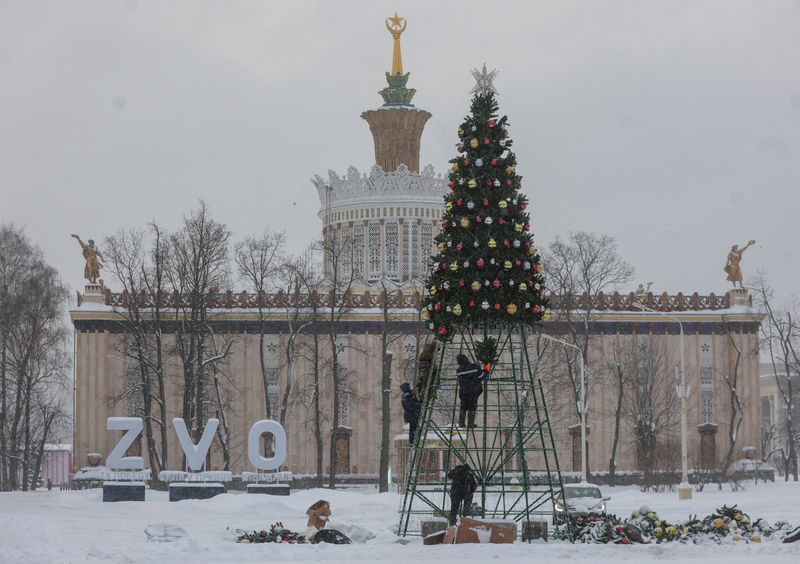Analysis: Russia’s military production, state splurge ease sanctions pain
2023.04.04 07:52

© Reuters. FILE PHOTO: Workers install Christmas and New Year decorations next to “Z”, “V” and “O” symbols in support of the Russian armed forces involved in the military conflict in Ukraine, during snowfall at the Exhibition of Achievements of National Economy (VDN
By Darya Korsunskaya and Alexander Marrow
MOSCOW (Reuters) – Rising military production and huge state spending are keeping Russia’s industry buzzing along, an analysis of recent data shows, helping soften the economic impact of Western sanctions and allowing Moscow to plough on with its campaign in Ukraine.
Last week’s official data showed annual industrial output decline slowed in February, largely thanks to the defence sector, offsetting some of the damage wrought mainly by sanctions on Russia’s key energy exports.
Russian industrial output fell 1.7% year-on-year in February after a 2.4% drop in January, data from the federal statistics service Rosstat showed.
“This is mainly an achievement of sectors with a high share of orders from the defence-industrial complex,” said Dmitry Polevoy, head of investment at Locko-Invest. “Without them, according to our rough estimates, the size of the decline in the rest of the industrial sector has not changed.”
Polevoy estimated that non-defence industrial production shrank about 8% year-on-year, while output of sectors with a high share of state defence orders jumped 36%.
Russia’s 5.41-trillion-rouble ($69 billion)expenditure on defence in 2022 exceeded the original plan by 54% and accounted for 17.4% of total budget spending, according to calculations by the Gaidar Institute, an independent Moscow-based think tank.
While soaring oil and gas prices and revenues – the lifeblood of Russia’s economy – supported spending last year, there are no signs of let-up this year, even as Western embargoes and price caps begin to weigh on energy exports.
The Gaidar Institute forecasts that “classified spending”, another indication of rising military-related expenditure, will account for 23% of Russia’s budget this year at 6.58 trillion roubles, up from 15.1% in 2021.
The decline in energy revenues has pushed Russia’s budget deficit to $34 billion in January-February, compared with a surplus of $4 billion in 2022.
Some analysts expect the budget deficit to widen to between 3% and 5% of gross domestic product this year from 2.9% in 2022 and beyond the finance ministry’s 2% target.
Still, despite the expected loosening of budget reins, non-military sectors are paying the price.
While spending on help for low-income households and families of fallen servicemen increased last year, spending on “national economy” – including roads, agriculture, and research and development – was down 3.9% in real terms, the Gaidar Institute said. Environmental protection expenditures slumped 31.9%, the institute pointed out.
LONG-TERM DECLINE
An independent study last month suggested Russia’s middle class will shrink as social inequality grows, even if sanctions get relaxed. A return to pre-conflict levels of prosperity remains a long way off.
“The economy as a whole is still feeling alright, supported by growing orders in the defence industry, massive budget injections at the end-2022 and early 2023,” said Polevoy, noting the successful redirection of oil and oil product supplies despite the sanctions.
“But it is difficult for an economist to call this situation completely ‘healthy’.”
Rosstat’s February economic data suggested an accumulation of long-term risks, with positive statistics primarily supported by large government spending, said Alfa Bank chief economist Natalia Orlova.
President Vladimir Putin last week highlighted record low unemployment and marginally higher real wages as evidence of Russia’s gradual economic recovery, but labour shortages and slumping consumer demand remain a concern.
“Overall, while current economic trends are better than our initial expectations, we think that the current positive figures are negative in terms of the Russian economy’s potential recovery,” said Orlova.
Ultimately, the numbers show that Russia is willing to keep diverting funds to the military, and will have enough funds to continue supporting what it calls a “special military operation” in Ukraine for a while, even if other sectors suffer.
To that end, Putin will have to keep his faith with the fiscal conservatism and reliable technocrats that so far have served him so well, Elina Ribakova, Senior Fellow at Bruegel and the Peterson Institute for International Economics, told Reuters.
“I think they will try to be cautious, they will cut all other spending, they will increase taxes on corporates,” Ribakova said. “There will be no growth, but they will not let a Venezuela scenario develop in Russia, because with rampant inflation and money printing, they are more likely to lose their hold on the economy,” she added.
“And I think Putin remembers that from the 90s.”
($1 = 78.6845 roubles)








